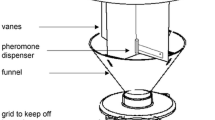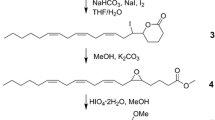Summary.
In the rove beetle Aleochara curtula, a male specific sternal gland is described. Isopropyl (Z9)-hexadecenoate has been identified by GC/MS of surface and sternal gland extracts as a male specific compound. Its emission in the air was demonstrated by closed-loopstripping-analyses. In field experiments, conspecific males and females were attracted by the odor of carrion, caged males from laboratory cultures, and by the synthetic ester. Isopropyl (Z9)-hexadecenoate or live males, combined with fresh carrion attract more beetles than a fresh carcass alone. Isopropyl hexadecanoate as a minor compound was not attractive. The term “aggregation” pheromone and the ecological significance of attracting females to a fresh carcass allowing early copulation and egg-deposition are discussed.
Similar content being viewed by others
Author information
Authors and Affiliations
Additional information
Received 20 August 1998; accepted 15 January 1999.
Rights and permissions
About this article
Cite this article
Peschke, K., Friedrich, P., Kaiser, U. et al. Isopropyl (Z9)-hexadecenoate as a male attractant pheromone from the sternal gland of the rove beetle Aleochara curtala (Coleoptera: Staphylinidae). Chemoecology 9, 47–54 (1999). https://doi.org/10.1007/s000490050033
Issue Date:
DOI: https://doi.org/10.1007/s000490050033




